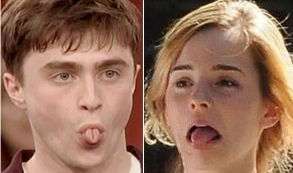Tongue-rolling: The myth
Some people can roll their tongue into a tube, and some people can't. This is one of the most common traits that biology teachers use to demonstrate basic genetic principles. Alfred Sturtevant (one of the pioneers of Drosophila genetics) described tongue rolling as a simple two-allele character, with the allele for rolling (usually given the symbol T or R) being dominant over the allele for non-rolling (t or r) (Sturtevant 1940). Many studies have shown that the myth is incorrect, but tongue rolling remains a popular subject in genetics classes.
The reality
Tongue rolling as a character
Most people, when first asked, either can easily roll their tongue (here called "R"), or cannot roll it at all ("NR"). The proportion of people who can roll their tongue ranges from 65 to 81 percent, with a slightly higher proportion of tongue-rollers in females than in males (Sturtevant 1940, Urbanowski and Wilson 1947, Liu and Hsu 1949, Komai 1951, Lee 1955). However, some people, especially children, cannot roll their tongue when first asked but later learn to do so (Sturtevant 1940). Komai (1951) found that the proportion of tongue-rollers among Japanese schoolchildren increased from 54 percent at ages 6-7 to 76 percent at age 12, suggesting that over 20 percent of the population learns to tongue-roll during that age range. That some people learn to roll their tongues after first being unable to is the first evidence that this is not a simple genetic character. There are also some people who can only slightly roll the edges of their tongue and cannot easily be classified as rollers or non-rollers (Reedy et al. 1971).
Family studies
Sturtevant (1940) compared parents and offspring, with the following results:
| Parents | R offspring | NR offspring |
|---|---|---|
| R x R | 28 | 5 |
| R x NR | 33 | 22 |
| NR x NR | 4 | 9 |
He concluded that tongue rolling was at least partially genetic, with rolling dominant to non-rolling, despite the four R offspring of NR x NR parents.
Komai (1951) performed a similar study with much larger sample sizes, and found similar results:
| Parents | R offspring | NR offspring | Percent R |
|---|---|---|---|
| R x R | 928 | 104 | 90% |
| R x NR | 468 | 217 | 68% |
| NR x NR | 48 | 92 | 34% |
In both family studies, individuals with tongue-rolling parents are much more likely to be tongue-rollers than individuals with non-rolling parents. It is difficult to imagine how the common family environment could influence tongue-rolling, so this resemblance between relatives suggests that there is a large genetic influence on tongue-rolling.
However, if this trait were a simple one-gene, two-allele genetic character, with rolling completely dominant to non-rolling, then two non-rolling parents could not have a rolling child. Both studies found rolling offspring of non-rolling parents, so the trait must be more complicated than the myth says. The discrepancy could be due to more complicated genetics, involving multiple alleles or multiple genes, or some kind of environmental influence.
Twin studies
Matlock (1952) found that out of 33 pairs of monozygotic (identical) twins, 7 pairs consisted of one R and one NR twin. This clearly establishes that there are important non-genetic influences on tongue rolling, and it convinced Sturtevant (1965) that tongue rolling was not determined solely by genetics. Reedy et al. (1971) and Martin (1975) also found numerous pairs of monozygotic twins who differed in tongue rolling. Dizygotic twins were twice as likely to differ in tongue-rolling ability as monozygotic twins (Reedy et al. 1971), which is additional evidence that there is some genetic influence on this trait.
| Matlock (1952) | Reedy et al. (1971) | Martin (1975) | Reedy et al. (1971) DZ twins | |
|---|---|---|---|---|
| Both R | 18 | 43 | 15 | 81 |
| Both NR | 8 | 11 | 5 | 21 |
| R + NR | 7 | 7 | 8 | 30 |
Conclusion
Family studies clearly demonstrate that tongue rolling is not a simple genetic character, and twin studies demonstrate that it is influenced by both genetics and the environment. Despite this, tongue rolling is probably the most commonly used classroom example of a simple genetic trait in humans. Sturtevant (1965) said he was "embarrassed to see it listed in some current works as an established Mendelian case." You should not use tongue rolling to demonstrate basic genetics.
References
Komai, T. 1951. Notes on lingual gymnastics. Frequency of tongue rollers and pedigrees of tied tongues in Japan. Journal of Heredity 42: 293-297.
Lee, J. W. 1955. Tongue-folding and tongue-rolling in an American Negro population sample. Journal of Heredity 46: 289-291.
Liu, T. T., T. C. Hsu. 1949. Tongue-folding and tongue-rolling in a sample of the Chinese population. Journal of Heredity 40: 19-21.
Martin, N. G. 1975. No evidence for a genetic basis of tongue rolling or hand clasping. Journal of Heredity 66: 179-180.
Matlock, P. 1952. Identical twins discordant in tongue-rolling. Journal of Heredity 43: 24.
Sturtevant, A. H. 1940. A new inherited character in man. Proceedings of the National Academy of Sciences USA 26: 100-102.
Sturtevant, A. H. 1965. A History of Genetics. Harper and Row, New York, NY.
Return to John McDonald's home page
This page was last revised December 8, 2011. Its address is http://udel.edu/~mcdonald/mythtongueroll.html. It may be cited as pp. 64-66 in: McDonald, J.H. 2011. Myths of Human Genetics. Sparky House Publishing, Baltimore, Maryland.
©2011 by John H. McDonald. You can probably do what you want with this content; see the permissions page for details.

